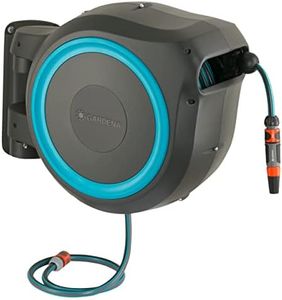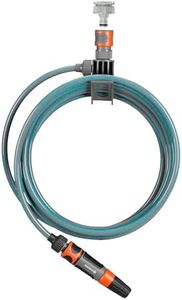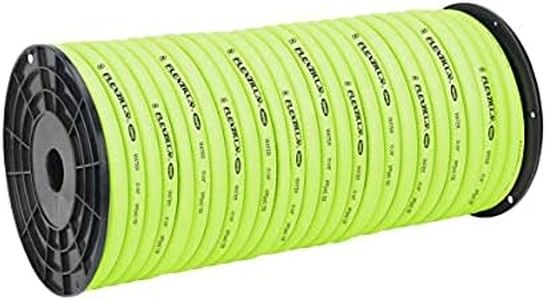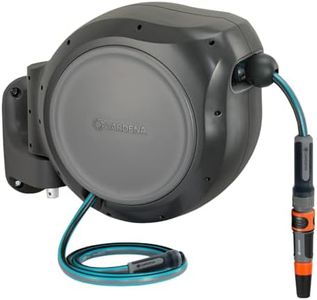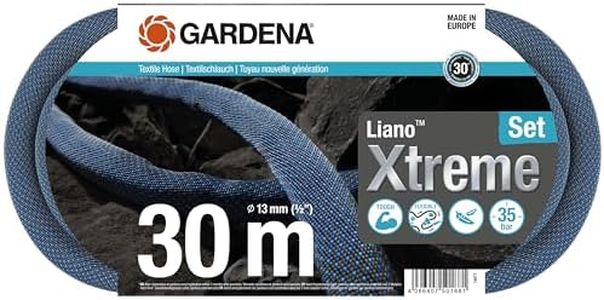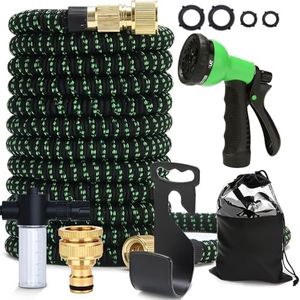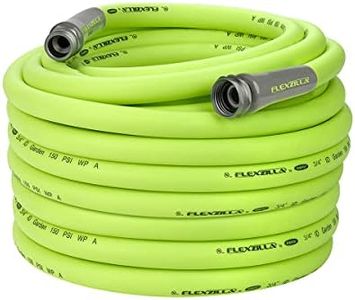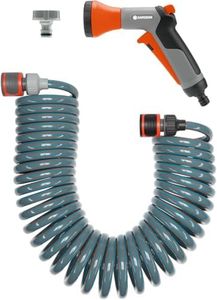We Use CookiesWe use cookies to enhance the security, performance,
functionality and for analytical and promotional activities. By continuing to browse this site you
are agreeing to our privacy policy
10 Best Water Hoses
From leading brands and best sellers available on the web.Buying Guide for the Best Water Hoses
Choosing the right water hose might seem simple, but there are key factors to consider that will significantly impact your experience and satisfaction. Whether you're watering your garden, washing a car, or using it around the house, knowing what to look for will help you avoid frustration and make your life a little easier. Start by thinking about where and how often you’ll use your hose, and then look at the hose specifications to find the best fit for your needs.LengthThe length of a water hose determines how far you can reach from the spigot or faucet. Hoses typically range from 25 to 100 feet. A longer hose means more reach, which is helpful for big yards, but it can also mean more weight, bulk, and a drop in water pressure. Short hoses (25-50 feet) are great for small gardens or patios, while medium (50-75 feet) work well for average urban yards. If you need to water far-off areas, a 100-foot hose is best, but consider if you really need the extra length or if moving the hose is practical. Pick the length based on the longest distance you need to cover, but try not to greatly exceed it.
DiameterDiameter is usually measured in inches and affects how much water comes out at once. The most common sizes are 1/2-inch, 5/8-inch, and 3/4-inch. A larger diameter allows more water to flow, which is better for filling buckets, soaking large gardens, or using sprayer attachments. Smaller diameters are lighter and easier to handle, and are fine for light watering. Pick a 1/2-inch hose for simple watering jobs and easy handling, 5/8-inch for general use and a good balance, and 3/4-inch if you want maximum water flow or work with pressure washers.
MaterialHoses can be made from rubber, vinyl, or a combination. Rubber hoses are stronger, more flexible, and less likely to kink, but they tend to be heavier and more expensive. Vinyl hoses are lighter and cheaper, but can kink or split more easily and may not handle rough use as well. Reinforced hoses often combine materials for strength and flexibility. If you need durability for regular or rough outdoor use, choose a rubber or reinforced hose. For light watering needs or easy storage, a vinyl hose may be enough.
Flexibility and Kink ResistanceA good hose should bend easily without kinking, which can block water and be frustrating. Flexibility depends on material, wall thickness, and special features like reinforcement. Test how easily the hose bends and check for claims of kink resistance. Some hoses are designed to be extra flexible without tangling. If you move your hose frequently or have lots of obstacles, prioritize kink resistance and flexibility. If you plan to leave it mostly stationary, this may be less important.
Couplings (Fittings)Couplings are the end pieces where you attach your hose to the spigot or a nozzle, usually made of plastic or metal (such as brass). Metal couplings are stronger and last longer but are usually heavier. Plastic couplings are lighter and cheaper but may crack or leak, especially if left in the sun or handled roughly. If you expect frequent attaching and detaching, or if durability matters, pick a hose with solid metal couplings. For occasional light duty, plastic may suffice.
Burst PressureBurst pressure tells you how much water pressure the hose can handle before it breaks, measured in PSI (pounds per square inch). Most home use doesn’t require very high PSI, but if you connect to a pressure washer or your spigot is very powerful, a higher rating is safer. Standard hoses suffice for normal watering, while heavy-duty uses need a higher burst pressure. Always pick a hose that exceeds the maximum pressure you expect.
WeightThe weight of the hose is mainly determined by its length and material. Heavier hoses tend to be more durable and offer higher flow, but they can be difficult for some people to drag around, especially when filled with water. Lightweight hoses are easy to maneuver but may wear out quicker. Think about how far you need to move the hose and how easy you want your gardening chores to be.
Storage FeaturesStorage considerations include whether a hose coils easily or features a design like expandable or flat hoses, which shrink in size when not in use. Standard hoses can be awkward to store if long, while expandable models are convenient for small spaces. Pick based on your storage area: If space is an issue, look for hoses that are slim or shrink when empty. If you have plenty of room and need durability, a traditional hose is fine.



